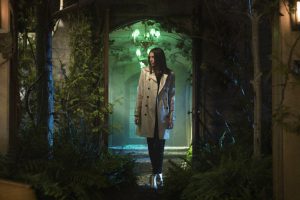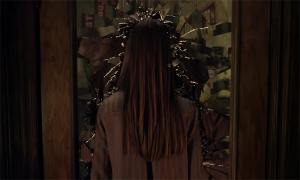Netflix’s Locke & Key opens a doorway into an expansive world of dark, cosmic magic that can only be described as deep: there are keys that lead to other keys, which open doors within doors, which then lead to puzzles, which connect back to clues, which are all supposed to interlock(e) – the problem comes toward the middle of the ten-part series, when it becomes clear that there’s no good way for everything to come together, because of a single plot point that splits the series’ focal point in two rapidly diverging directions, which never reunite (and never seem likely to, assuming there is a second season – there’s certainly set-up for one).

Without getting into spoilers, I’ll explain it like this: after a couple of really strong episodes, Locke & Key introduces an idea that immediately forces the adult characters – including the series’ most compelling character, recovering alcoholic and traumatized widow Nina Locke (Darby Stanchfield) – and the teen or young adult characters – specifically her children, Tyler (Connor Jessup), Kinsey (Emilia Jones), and Bode (Jackson Robert Scott) – to pursue two very different paths. The adults are left with many of the hard-hitting emotional and dramatic moments, but the kids have to awkwardly carry the horror/fantasy plotline to its conclusion. This divide is…uncomfortable, to say the least, and it also makes both parties look bad: the adults seem naive and negligent for barely ever interfering in their kids’ lives; the kids come off as idiotic and downright mean for never going to the adults for help or advice. And again, this is all because of one plot-point that is never even properly explained: this particular plot-point also seems oddly kiddish in a series that tries to be more edgy, dark and mature than it probably needs to be.
That darker vibe, while inconsistent, does allow for a somewhat memorable antagonist: the beautiful, haunting demon lurking in the well, whose actual name – “Dodge” – is far less threatening than either of her nicknames, “Well-Lady” or “Echo”. Portrayed by Laysla De Oliveira, the ancient demonic entity is able to do a fair bit of damage and wrack up an impressive kill-count, all with style and grace, even while being restricted by another very specific plot-point that forbids her from murdering absolutely everybody in her path towards…whatever it is she’s fighting for (it’s never actually explained what that is, making her sudden shift from “haunted house ghost” to “immortal Lovecraftian shadow goddess” inexplicable, yet still entertaining).

Like Dodge, the entire series gets an upgrade about halfway through – which is both a blessing and a curse, as it simultaneously raises the stakes for all the protagonists while also closing the door on the fun, spooky treasure-hunt adventure that made the first few episodes so unique. The central trio of Locke children splits up, with the two older kids pursuing the main plot with their rapidly expanding group of high-school friends and enemies, while Bode (the most interesting of the three by far) is left at home, shoved to the sidelines, and kept in the dark…despite being the one who initially found the keys and unleashed Dodge. This series has a hard time remembering who its main characters are, at times. The high school story is intermittently dull, with subplots related to clam chowder, charity fundraisers, poorly-developed love triangles and generic bullies. It’s no coincidence that this coincides with the sudden, strange decision to make the story all about Tyler Locke, the most boring, familiar, and downright annoying of the main trio (he seems to have a smoking addiction in the first episode, yet turns on his mother for drinking later in the series: hypocritical much, Tyler?) and the one who seems to have the least interest in the plot.
I might sound like I’m coming down hard on this show. But the series does have moments – sometimes even scenes – of true greatness: especially when it comes to the many inventive or witty ways in which the characters use their magic keys, either for good, evil, or stupid pranks. Kinsey using the Head Key to step inside her brain and battle it out with the personification of her own fears and insecurities? Excellent stuff. Dodge using the Anywhere Key to order breakfast at a small-town diner, go shopping at a high-end fashion mall, pull off a diamond-heist and attend a nightclub party all within a few moments? Fantastic. Anything involving the Ghost Key? Brilliant.

Unfortunately, the scenes involving magic often require…magic, a.k.a. a CGI budget that this show clearly does not have at its disposal. The fight scenes with monsters, ghouls and demons are often all too brief, and darkly-lit (probably for the best, as the notable exception to this rule, involving a zombie-type creature attacking someone in broad daylight, looks painfully fake), while keys like the Matchstick and Ghost Key are used sparingly. This wouldn’t even be a problem if the series didn’t try to make itself larger than it had to be – when you’re just running around a spooky mansion, you don’t really need a whole bunch of special effects: when you’re on the brink of unleashing primordial powers from beyond the edge of the world into your small coastal town, that’s something else entirely.
Another issue with the magic system is that it never gets explained: why does it exist? Who made the keys, and why? What is Dodge? What is she doing? Who are the Lockes, and where did they come from? These are questions that are not only never answered, but never get raised in the first place. It’s not like there’s no reason to bring up any of these very important points: the Locke family are fighting to keep themselves and their loved ones safe, yet they never even seem to question how freaky and terrifying their lives have become. By the end of the series, they seem to have all nonchalantly settled down into a daily routine of nightmares, monstrous encounters in the woods, murderous escapees, demons breaking-and-entering, and a weirdly high number of people attacking each other with hammers (I mean, I get it, Nina is a carpenter and all, but are there no other available weapons in Keyhouse? They’ve got not one, but two wicked-looking swords mounted on the mantelpiece, and yet they choose hammers and plastic lightsabers to vend off intruders? Seriously?)
The series is fairly progressive, though fans of the original Locke & Key graphic novels will be disappointed to hear that Duncan Locke (Aaron Ashmore), an openly gay, happily married character in the comic, has a very small recurring role, and is nowhere shown to be gay, as he’s conveniently separated from his husband (whose name is, to be fair, mentioned once or twice) throughout the series.
All in all, Locke & Key has an amazing premise, and a couple of really good episodes: but it doesn’t take long before the plot, the characters and the entire series get lost in the dark. Will you find what you’re looking for amid the Gothic splendor of Keyhouse? I certainly hope so, because I feel like there’s potential somewhere in this story: potential that could be unlocked in a second season.
Series Rating: 5.9/10